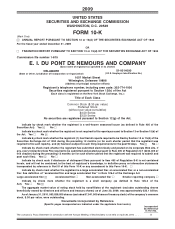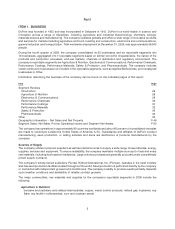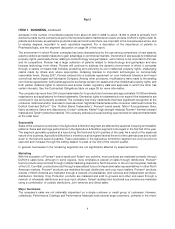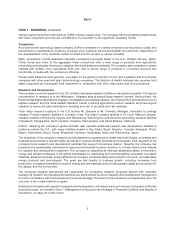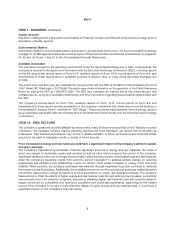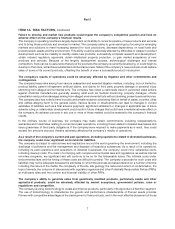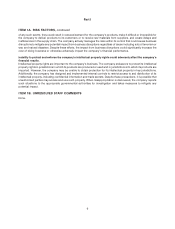DuPont 2009 Annual Report Download - page 7
Download and view the complete annual report
Please find page 7 of the 2009 DuPont annual report below. You can navigate through the pages in the report by either clicking on the pages listed below, or by using the keyword search tool below to find specific information within the annual report.Part I
ITEM 1. BUSINESS, continued
Facility Security
See Item 7, Management’s Discussion and Analysis of Financial Condition and Results of Operations on page 45 for a
discussion of facility security.
Environmental Matters
Information related to environmental matters is included in several areas of this report: (1) Environmental Proceedings
on page 12, (2) Management’s Discussion and Analysis of Financial Condition and Results of Operations on pages 24,
41–45 and (3) Notes 1 and 20 to the Consolidated Financial Statements.
Available Information
The company is subject to the reporting requirements under the Securities Exchange Act of 1934. Consequently, the
company is required to file reports and information with the Securities Exchange Commission (SEC), including reports
on the following forms: annual report on Form 10-K, quarterly reports on Form 10-Q, current reports on Form 8-K, and
amendments to those reports filed or furnished pursuant to Section 13(a) or 15(d) of the Securities Exchange Act
of 1934.
The public may read and copy any materials the company files with the SEC at the SEC’s Public Reference Room at
100 F Street, NE, Washington, DC 20549. The public may obtain information on the operation of the Public Reference
Room by calling the SEC at 1-800-SEC-0330. The SEC also maintains an Internet site at http://www.sec.gov that
contains reports, proxy and information statements, and other information regarding issuers that file electronically with
the SEC.
The company’s annual report on Form 10-K, quarterly reports on Form 10-Q, current reports on Form 8-K and
amendments to those reports are also accessible on the company’s website at http://www.dupont.com by clicking on
the tab labeled ‘‘Investor Center’’ and then on ‘‘SEC filings.’’ These reports are made available, without charge, as soon
as is reasonably practicable after the company files or furnishes them electronically with the Securities and Exchange
Commission.
ITEM 1A. RISK FACTORS
The company’s operations could be affected by various risks, many of which are beyond its control. Based on current
information, the company believes that the following identifies the most significant risk factors that could affect its
businesses. Past financial performance may not be a reliable indicator of future performance and historical trends
should not be used to anticipate results or trends in future periods.
Price increases for energy and raw materials could have a significant impact on the company’s ability to sustain
and grow earnings.
The company’s manufacturing processes consume significant amounts of energy and raw materials, the costs of
which are subject to worldwide supply and demand as well as other factors beyond the control of the company.
Significant variations in the cost of energy, which primarily reflect market prices for oil and natural gas and raw materials
affect the company’s operating results from period to period. Legislation to address climate change by reducing
greenhouse gas emissions and establishing a price on carbon could create increases in energy costs and price
volatility. When possible, the company purchases raw materials through negotiated long-term contracts to minimize
the impact of price fluctuations. Additionally, the company enters into over-the-counter and exchange traded derivative
commodity instruments to hedge its exposure to price fluctuations on certain raw material purchases. The company
takes actions to offset the effects of higher energy and raw material costs through selling price increases, productivity
improvements and cost reduction programs. Success in offsetting higher raw material costs with price increases is
largely influenced by competitive and economic conditions and could vary significantly depending on the market
served. If the company is not able to fully offset the effects of higher energy and raw material costs, it could have a
significant impact on the company’s financial results.
6

